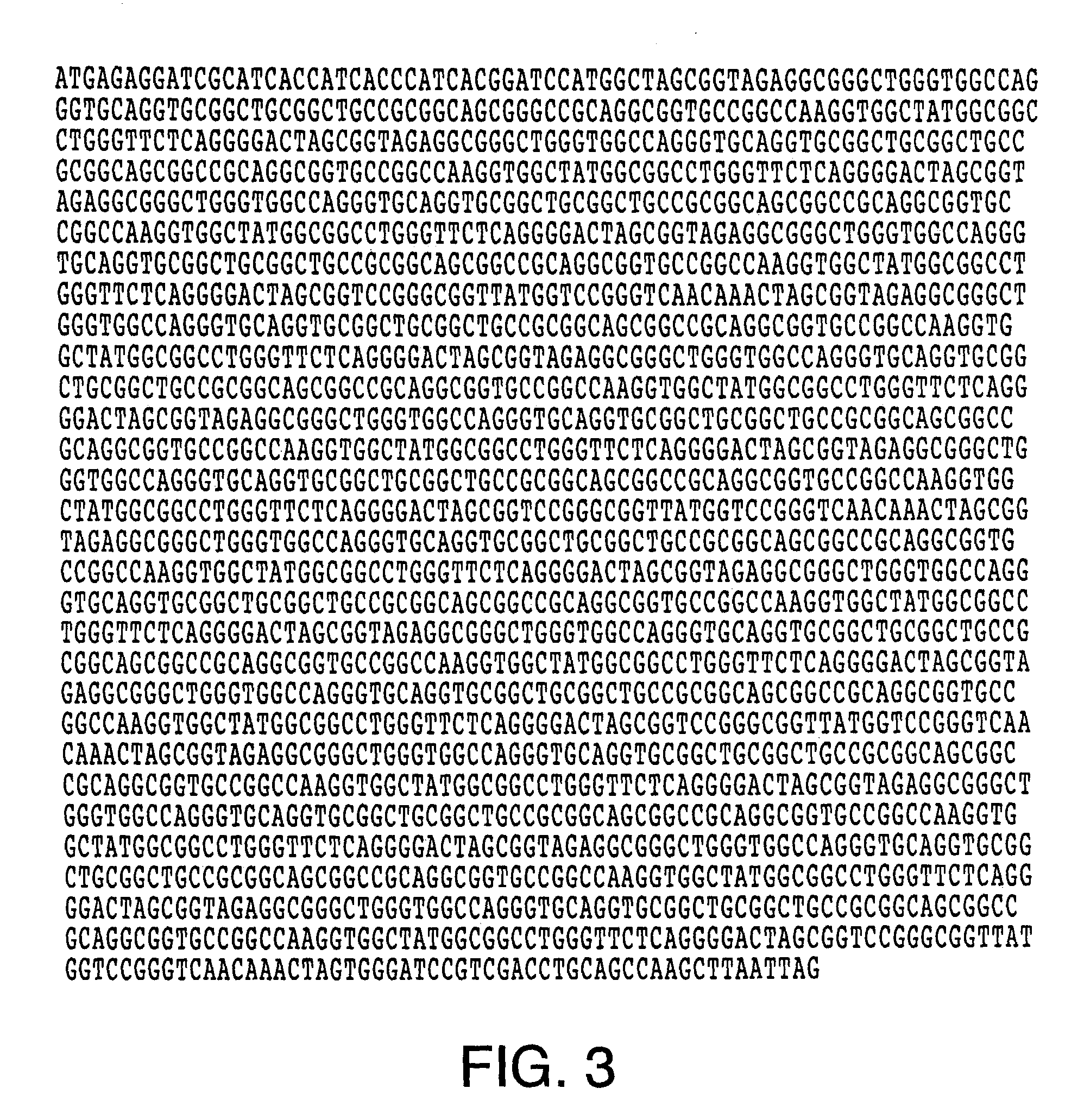Methods for the purification and aqueous fiber spinning of spider silks and other structural proteins
a technology of spider silk and other structural proteins, which is applied in the direction of monocomponent protein artificial filaments, peptide sources, peptide/protein ingredients, etc., can solve the problems of increasing the antigenicity of the protein, affecting the properties of fibers, films, etc., and achieves less time, less steps, and less reagent volume
- Summary
- Abstract
- Description
- Claims
- Application Information
AI Technical Summary
Problems solved by technology
Method used
Image
Examples
example 1
Purification of Recombinant Silk Protein with Formic Acid and Ion Exchange Chromatography
[0069]In this example, the gene product of pQE(sp1)7 (SEQ ID NO: 1), as set out in FIG. 1, is expressed as recombinant silk protein pQE(SP1)7 (SEQ ID NO: 2), as set out in FIG. 2, in E. coli as described elsewhere (Prince et al., 1995). The (sp1)7 gene was cloned into the expression vector pQE-9 (Qiagen) and transformed into the host cell line SG13009pREP4 (Stratagene). Cultures were grown to an A600=1.5-2.0 in 4×YT medium (per liter: 32 g tryptone, 20 g yeast extract, 5 g NaCl) containing 400 ug / mL ampicillin. Protein expression was induced by the addition of isopropyl-thiogalactopyranoside (IPTG) to a final concentration of 1 mM. After 1-4 hours the cells were harvested by centrifugation and stored for purification. Lyophilized pellets were lysed in 23N formic acid (100 ml / g cell pellet), diluted to 4.6N acid with distilled and deionized water and stirred 1 hour at room temperature. The cell l...
example 2
Purification of Recombinant Silk Protein with Propionic Acid and Ion Exchange Chromatography
[0070]In this example, the gene product of pQE[(SP1)4 / (SP2)1]4 (SEQ ID NO: 3), as set out in FIG. 3, is expressed as recombinant silk protein pQE[(SP1)4 / (SP2)1]4 (SEQ ID NO: 4), as set out in FIG. 4, in E. coli (Prince et al., 1995). The [(SP1)4 / (SP2)1]4 gene was cloned into the expression vector pQE-9 (Qiagen) and transformed into the host cell SG13009pREP4 (Stratagene). Cultures were grown to an A600=1.5-2.0 in 4×YT medium (per liter: 32 g tryptone, 20 g yeast extract, 5 g NaCl) containing 400 ug / mL ampicillin. Protein expression was induced by the addition of IPTG to a final concentration of 1 mM. After 1-4 hours the cells were harvested by centrifugation and stored for purification. Lyophilized pellets were lysed in 13.3N propionic acid (2 ml / g cell pellet), diluted to 2.3N acid with distilled and deionized water and stirred 1 hour at room temperature. The cell lysate was clarified by cen...
example 3
Purification of Recombinant Silk Protein with Propionic Acid and Ion Exchange Chromatography
[0071]In this example, the gene product of pET [(SP1)4 / (SP2)1]4 (SEQ ID NO: 5), as set out in FIG. 5, is expressed as recombinant silk protein pET[(SP1)4 / (SP2)1]4 (SEQ ID NO: 6), as set out in FIG. 6, in E. coli (Prince et al., 1995). The [(SP1)4 / (SP2)1]4 gene was cloned into the expression vector pET24 (Novagen Inc.) and transformed into the host cell BL21 (DE3) pLysS. Cultures were grown to an A600=19 in defined medium (per liter: 13.3 g KH2PO4, 4 g (NH4)2HPO4, 1.7 g Citric acid, 25 g glucose, 1.2 g MgSO4-7H2O, 39 mg FeCl3, 13 mg MnSO4—H2O, 10 mg ZnSO4-7H2O, 3 mg H3BO3, 2.5 mg Na2MoO4-2H2O, 2.5 mg CoCl2-6H2O, 1.8 mg Cu(CH3COO)2—H2O, 6.7 mg EDTA, 4.5 mg thiamine-HCl) with kanamycin (30 ug / ml) at 37° C., 16 liter / min air and 600 rpm. Expression was induced for 1 hr with 1 mM IPTG at which time the cells were harvested by centrifugation and stored for purification. Lyophilized pellets were lys...
PUM
| Property | Measurement | Unit |
|---|---|---|
| length | aaaaa | aaaaa |
| diameter | aaaaa | aaaaa |
| diameter | aaaaa | aaaaa |
Abstract
Description
Claims
Application Information
 Login to View More
Login to View More - R&D
- Intellectual Property
- Life Sciences
- Materials
- Tech Scout
- Unparalleled Data Quality
- Higher Quality Content
- 60% Fewer Hallucinations
Browse by: Latest US Patents, China's latest patents, Technical Efficacy Thesaurus, Application Domain, Technology Topic, Popular Technical Reports.
© 2025 PatSnap. All rights reserved.Legal|Privacy policy|Modern Slavery Act Transparency Statement|Sitemap|About US| Contact US: help@patsnap.com



